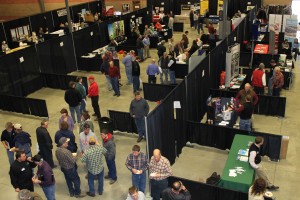DALTON, Ohio — Dairy farmers were challenged to continue improving the quality of their milk and their consumer image during the annual Northeast Ohio Regional Dairy Conference, held Feb. 20 in Dalton.
Speakers addressed “the hows and whys of quality milk” and the many things farmers can do to reduce somatic cell count and improve cow health.
Pamela Ruegg, professor and extension milk quality specialist with the University of Wisconsin at Madison, said a lot of it has to do with common sense planning, and making sure everyone on the farm follows the plan.
“It’s based on good management of cows, good management of milking and good management of the environment,” she said. “There’s simply no shortcuts. Dairy farming is a complicated, science-based business (of) producing high quality milk.”
The mammary infection “mastitis” usually happens through direct exposure from another infected cow, or from encounters in the barn or pasture where the bacteria lives in the cow’s natural environment. Ruegg said it’s important to manage both the cow and her environment to the fullest extent.
Follow the plan
A common problem, she said, is not training the milk help with best practices. Workers need to know the farm’s policy for milking, she said, and how to handle teat dipping, milk parlor management and cow health.
Ruegg said the days of farmers making their own teat dip solution are gone and encouraged them to spend the extra money to invest in a commercially-proven product. She also said it’s a must to use separate towels on each cow’s teats, to prevent any chance of spreading bacteria.
No matter how hard a dairy farmer tries, though, Ruegg said it’s still going to be difficult to keep teats clean because the design of the cow naturally leads to the potential for manure and bacterial exposure.
“God designed the cow incorrectly,” she said half-jokingly.
According to Ruegg, it would have been better to have the cow’s teats on her backside, where here would be more distance from the manure and waste.
International markets
Ken Vorgert, chief of the U.S. Department of Agriculture’s Dairy Grading Branch, gave an update on the international significance of quality milk.
A lower somatic cell count means more food uses for the milk, a longer shelf life and better quality food products.
“You want a consistently high quality product to make a high quality end product,” he said.
Vorgert said farmers can about triple the expected shelf life of their product when they reduce somatic cell count, which is especially important for overseas marketing.
Milk shipped to other countries receives an export certification. As of Jan. 1, 2012, U.S. farms and companies wanting to ship to the European Union were made to adhere to new standards, including monthly on-farm inspections.
The U.S. regulatory limit for somatic cells counts in milk is 750,000 cells/mL. To be EU certified, the limit is significantly lower, at 400,000 cells/mL.
Both speakers offered the following basic tips to achieve a lower somatic cell count and reduce chances of mastitis. If you’re an experienced dairy farmer, these tips may seem like common sense, but they’re also good reminders.
Better milk:
— Somatic cells are affected by management practices that expose teats to mastitis-causing bacteria. This usually happens through exposure to milk from infected cows, or through poor environmental conditions in the barn or pasture.
— Use a recommended teat dipping procedure, including a quality teat dip solution. One towel per cow is the rule, and be sure all employees follow the rules.
— Record all cases of mastitis in each cow and monitor the outcomes. Cull any chronically infectious cows.
— Establish and follow a thorough milking machine maintenance program.
— Use dry-off therapy for infected quarters and udders. Separate infected cows or use separate milking equipment.
— Maintain clean bedding material and environment. Organic bedding material usually leads to more moisture and negative bacteria. Size of the pen or stall should conform to the size of the cows, to keep the most waste possible in the manure aisle and away from the udder.
The Northeast Ohio Regional Dairy Conference is presented by the dairy veterinarians of the Killbuck Valley Veterinary Medical Association.











